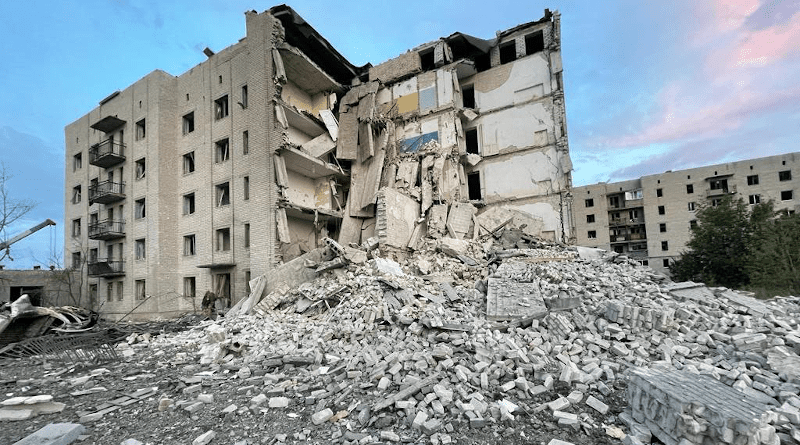Russia Orders Troops To Intensify Attacks As Missiles, Shelling Blast Ukrainian Cities
By RFE RL
(RFE/RL) — Ukrainian authorities reported that Russian missile strikes and shelling had killed at least 16 civilians in cities throughout the country after the Kremlin’s military leaders said they had ordered troops to “further intensify” their actions in all areas.
Residents of Kyiv sought cover on July 16 as air-raid sirens blared across the Ukrainian capital, while Ukraine’s most senior atomic official accused Russian troops occupying Europe’s largest nuclear plant at Zaporizhzhya of using it to shell nearby areas and store advanced weapons.
The reports could not be independently confirmed, but they come amid a flurry of deadly Russian strikes on civilian sites, including an attack in the historic city of Vinnytsya on July 15 that killed 24 people.
Russia claimed the strike targeted officers’ housing, but Ukrainian and U.S. officials rejected that assertion and said the attacks hit civilian sites. At least 39 people remained missing following the strike.
After failing to take Kyiv in the early days of the war, Russia has turned its main focus on taking all of the Donbas region — consisting of the eastern provinces of Donetsk and Luhansk.
But fresh attacks have been reported as well in the north and south of Ukraine. The northeast city of Kharkiv, the country’s second-largest, has been blasted by heavy bombardments in recent days. Ukrainian officials said the Kremlin’s next move could be a full-scale attack on the city of 1.45 million people.
Serhiy Bolvinov, deputy head of the Kharkiv regional police, said Russian rockets blasted a two-story apartment block and other buildings.
“Four Russian rockets, presumably fired from around [the Russian city of] Belgorod at night, at about 3:30 a.m., hit a residential building, a school, and administrative buildings,” Bolvinov wrote on Facebook.
“The bodies of three people were found under the rubble. Three more were injured. The victims are civilians,” Bolvinov added.
On July 16, the Russian Defense Ministry said Defense Minister Sergei Shoigu gave “instructions to further intensify the actions of units in all operational areas, in order to exclude the possibility of the Kyiv regime launching massive rocket and artillery strikes on civilian infrastructure and residents of settlements in Donbas and other regions.”
In the Donetsk region, site of the heaviest fighting, seven civilians were killed and 14 wounded over the past 24 hours in attacks on cities, its governor said on July 16.
However, Serhiy Hayday, governor of the neighboring Luhansk region, said Ukrainian troops had repelled a Russian overnight assault on a strategic eastern highway. He said Russian forces had been attempting to capture the main road link between the cities of Lysychansk and Bakhmut “for more than two months.”
“They still cannot control several kilometers of this road,” Hayday wrote on Telegram.
Ukrainian President Volodymyr Zelenskiy said in his nightly video address late on July 16 that air-raid warnings were being sounded across the country, including in Dnipro and Kremenchuk, two cities south of Kyiv along the Dnieper River.
He said the Russians “are realizing that we are gradually becoming stronger” and were using attacks on cities to “pressure” and “intimidate” Ukrainians.
The Ukrainian Army’s General Staff said early on July 16 that their forces had successfully repelled assault operations by Russian troops near the Spirne-Ivano-Daryivka areas of Donetsk.
Late on July 16, in Odesa, a key port city on the Black Sea that has not seen heavy shelling as of yet, a Russian missile hit a warehouse, igniting flames and sending up a plume of black smoke. No injuries were immediately report.
A day earlier, Maksym Marchenko, head of the Odesa military administration, said Russian troops had fired three missiles on Odesa Oblast, with one missile being shot down by Ukrainian air defense systems.
Elsewhere, Ukrainian nuclear agency Energoatom President Petro Kotin said in a televised interview that the situation at Zaporizhzhya is “extremely tense” and pressure on the Russians to free the area’s nuclear plant “insufficient.”
Around 500 Russian soldiers are said to be controlling access to Zaporizhzhya, which lies on the Dnieper River in southeastern Ukraine and has been in Russian hands since the early weeks of the invasion.
“The occupiers bring their machinery there, including missile systems, from which they already shell the other side of the Dnieper River and the territory of Nikopol,” Kotin said.
He also criticized the International Atomic Energy Agency’s handling of the situation around Zaporizhzhya, which before the war supplied around one-fifth of Ukraine’s domestically generated energy.
“[The IAEA] is playing some political games, balancing between Russia and Ukraine,” Kotin said.

